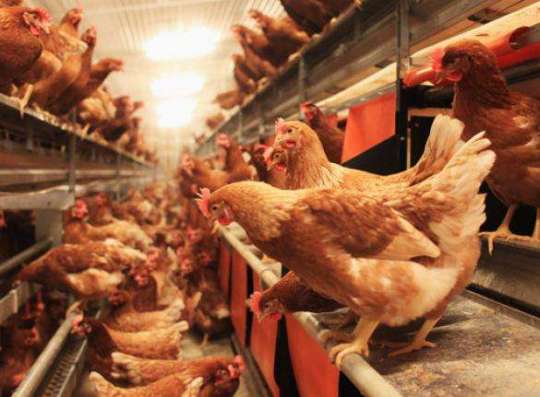- Feed accounts for 70% of production cost
- 80% farmers in Accra out of business
Without swift action and long-term resolve, the local poultry industry could collapse due to sustained rises in price of inputs.
Currently, feed alone accounts for about 70 percent of farms’ daily production cost – having jumped from 35 percent since the third quarter of 2022. The situation is further compounded by competition from cheaper imports, outbreaks of disease or pests, poor access to finance and high electricity bills.
As a result, industry players say the once-buoyant industry is experiencing one of its worst times, with as many as 80 percent of farmers in Accra losing their livelihoods due to high production costs, according to the Greater Accra Poultry Farmers Association.
Joseph Boakye-Yiadom, Chief Executive Officer of Joerees Farms – who boasts 35,000 layers and 10,000 broiler birds and with more than a decade experience being a farmer – noted that just a little over a year ago feed cost was about 30 percent – 35 percent of the total daily production cost, but it has now jumped to 70 percent. This, he said, has made it nearly impossible for most farms to stay afloat.
“In the past, after deducting production cost including labour and utilities, the farmer was left with 50 percent profit. Therefore, even if the flock-production of eggs is at 80 percent, the farmer still gets a significant profit,” Mr. Boakye-Yiadom said.
The story today, he narrated, is a completely different one as most farms have had to either shut-down or diversify to stay in business due to rising cost of production.
It is estimated that over 10 million people in Ghana eat a meal with chicken every day. This translates to over 2 million birds. However, less than 3 percent of the meat is locally produced.
With the sector’s ongoing plight, it is feared the poultry products market could be lost completely to imports.
“Even if 50 percent is locally produced, says Mr. Boakye-Yiadom, “it will directly create sustainable employment for farm hands, transporters, processors and distributors.”
Similarly, Chairperson of the Greater Accra Poultry Farmers Association, Gifty Rodor, sharing her sentiments about the plight of poultry farmers indicated that 80 percent of her members have lost their means of livelihood due to high cost of production, particularly feed.
“Some of us are resilient – we still have about 20 percent of our members in the poultry sector in operation, so it has not totally collapsed. But then, government needs to show a lot of commitment in order to sustain us. We have had several meetings with government concerning the rising cost of inputs and how it is affecting us negatively, but nothing has changed.
“At the behest of government, we have also provided a 10-year-strategic-plan in the form of a proposal outlining strategic means by which the poultry sector can be revamped – which we have sent copies of to the Ministry of Food and Agriculture (MoFA) as well as Ministry of Trade and , but that has also not yielded any results. The Poultry Farmers Association of Ghana have also written in-depth proposals for government to work on; but government has turned a deaf ear to their pleas,” she lamented.
Worryingly, she said, the School Feeding Programme that has potential to partially sustain the sector has stopped buying eggs from local farmers, and instead is importing mackerel and sausage from China to feed schoolchildren.
“They have stopped procuring the eggs,” she lamented: “They are now feeding students with imported mackerel and sausage from china.
“How can you reject local eggs that are so nutritious and go for imported mackerel and sausages that are sodium-laden to feed schoolchildren? Is it because somebody wants to make undue profit at the expense of local jobs?” she asked.
Recommendations
On ways to revamp the industry, Madam Rodor recommended government should consider a policy that compels importers to obtain about 40 percent of chicken from local farmers while the remaining 60 percent comes from imports. This, when done, could ensure the industry’s survival over the next 5 to 10 years.
“Government can also bring large-scale maize and soya producers together and help enable them to access loan facilities from banks at lower interest rates, empowering them to go into full-scale mechanisation and irrigation systems. We have proposed this to the sector ministry and Agricultural Development Bank – emphasising that if they do this, then the cost of inputs will stabilise,” she noted.
She further underscored the need for government to shift from rain-fed agriculture, which in her estimation is no longer sustainable due to climate change and its attendant erratic weather pattern changes – to adopting an irrigation system of agriculture, so as to ensure the availability of soya and maize.
“Government needs to focus on irrigation and mechanisation for commercial farms as well as large-scale farming activities; and empower the Grains Development Authority or the buffer stock to procure maize and soya from commercial grain farmers when it is produced, and then store them in warehouses or silos so that poultry farmers can go there and buy their feed. This will ensure stable prices throughout the year.
“Farmers themselves do not have the facility and financial muscle needed to procure the grain and store all-year-round,” she advocated.
Meanwhile, the Chief Executive Officer of Joerees Farms added that the poultry value chain has a lot of potential to create sustainable employment for many people – if given the needed support and attention.










